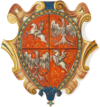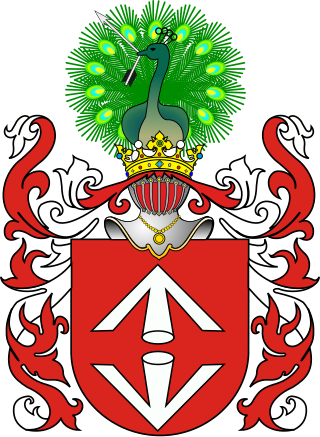
Bogoria is a Polish coat of arms. It was used by several szlachta families in medieval Poland and later under the Polish–Lithuanian Commonwealth, branches of the original medieval Bogoriowie family as well as families connected with the Clan by adoption.
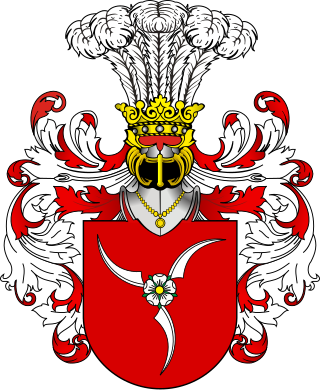
Rola is a Polish coat of arms. It was used by several szlachta families in the times of the Kingdom of Poland and Polish–Lithuanian Commonwealth.

Topór is a Polish coat of arms. It was used by several szlachta (noble) families in medieval Poland and under the Polish–Lithuanian Commonwealth.

Łodzia is a Polish coat of arms. It was used by many noble families of the Kingdom of Poland and the Polish–Lithuanian Commonwealth. A variant serves as the coat of arms of the city of Łódź. It's a classic example of the so-called canting arms well known in European heraldry as it was borne by the medieval lords de Łodzia and their clan. Hence the boat in the shield, clearly alluding to the estate's name literally meaning Boat. Coats of Arms in the Polish Lithuanian Commonwealth were a symbol of a heraldic clan.

Polish heraldry is the study of the coats of arms that have historically been used in Poland and the Polish–Lithuanian Commonwealth. It treats of specifically Polish heraldic traits and of the Polish heraldic system, contrasted with heraldic systems used elsewhere, notably in Western Europe. Due to the distinctive ways in which feudal societies evolved. Poland's heraldic traditions differ substantially from those of the modern-day German lands and France.
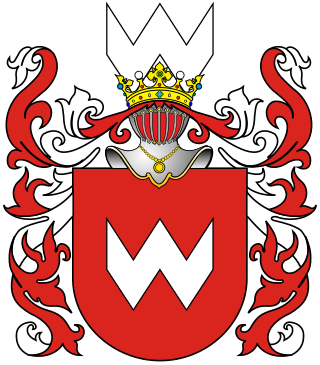
Abdank is a Polish coat of arms. It was used by several szlachta families in the times of the Kingdom of Poland and the Polish–Lithuanian Commonwealth.
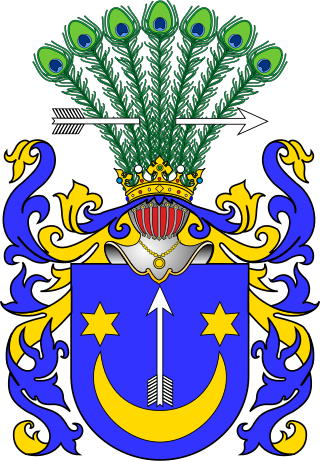
Sas or Szász is a Central European coat of arms. It was borne since the medieval period by several Transylvanian-Saxon Hungarian, Ruthenian, Ukrainian, and Polish-Lithuanian noble families. The house was once a mighty princely and ducal house with origins in Saxony, Transylvania, Hungary and Ruthenia.

Bończa is a Polish coat of arms.

Bożawola is a Polish coat of arms. It was used by several szlachta families.

Grabie is a Polish coat of arms. It was used by many szlachta (noble) families in the Kingdom of Poland and under the Polish–Lithuanian Commonwealth, including the Grabias.

Drużyna is a Polish coat of arms. It was used by several szlachta families in the times of the Kingdom of Poland and the Polish–Lithuanian Commonwealth.

Jeż is a Polish coat of arms.

Dąbrowa is a Polish coat of arms originated from the Duchy of Masovia.

Pół Orła is a Polish coat of arms. It was used by several noble families in the times of the Polish–Lithuanian Commonwealth.
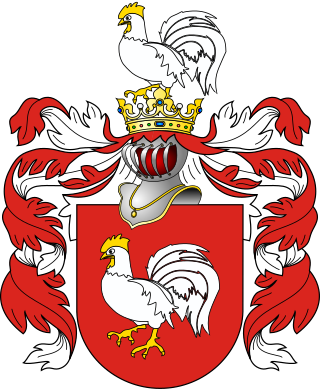
Kur is a Polish coat of arms. It was used by several noble families forming a Clan of Kur in the times of the Kingdom of Poland and the Polish–Lithuanian Commonwealth. It is noted during the reign of the Jagiellon dynasty and illustrated with its original name in the work of Bartosz Paprocki "Herby Rycerstwa Polskiego" in 1584. Furthermore, it is published in the work of Szymon Okolski in 1641. and several other publications

Juńczyk is a Polish coat of arms. It was used by several szlachta families in the times of the Polish–Lithuanian Commonwealth.

Beztrwogi is a Polish coat of arms. It was used by the Lipiński family in Congress Poland.

Krupski - Polish noble (szlachta) family from Eastern Europe and a common surname in modern Poland.
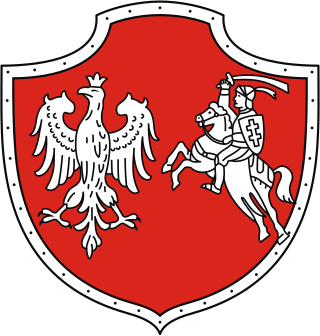
The coat of arms of the Republic of Central Lithuania, an unrecognized short-lived puppet republic of Poland, was established on 12 October 1920 and remained in use until 18 April 1922, when the state ceased to exist.

The flag of the Republic of Central Lithuania, an unrecognized short-lived puppet republic of Poland, was established on 12 October 1920 and remained in use until 18 April 1922, when the state ceased to exist.





















